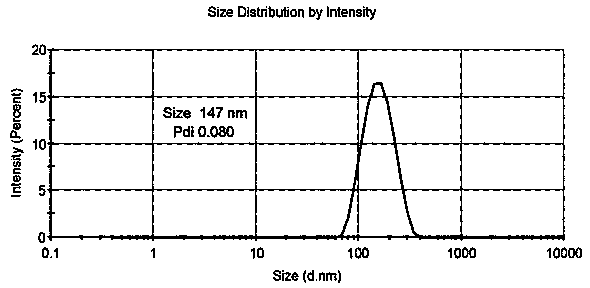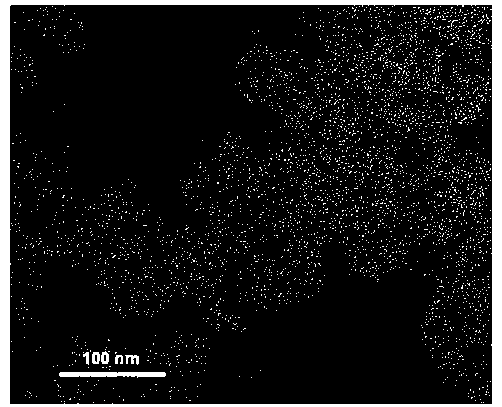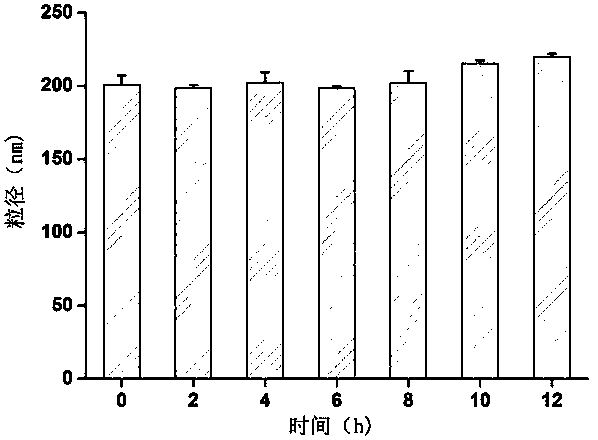Chemotherapeutic drug-photosensitizer co-assembled nanoparticles and construction thereof
A co-assembly and nanoparticle technology, which is applied in drug combinations, antineoplastic drugs, pharmaceutical formulations, etc., can solve the problems of easy crystallization or leakage of drugs, poor stability, toxic and side effects, etc., and achieve easy surface modification, small particle size, and easy Amplify the effect of production
- Summary
- Abstract
- Description
- Claims
- Application Information
AI Technical Summary
Problems solved by technology
Method used
Image
Examples
Embodiment 1
[0034] Example 1: Preparation of non-PEGylated mitoxantrone-pyropheophytin a co-assembled nanoparticles
[0035] A certain amount of mitoxantrone (MTX) and pyropheophytin a (PPa) were dissolved in a mixed solvent (methanol / tetrahydrofuran=50 / 50, v / v) to prepare 10mM MTX stock solution and 10mM PPa stock solution .
[0036] When the molar ratio of chemotherapeutic drug to photosensitizer was 6:1, the mixed solution (900 μL MTX solution and 150 μL PPa solution) was added dropwise to 3 mL deionized water at a stirring speed of 900 rpm. The organic solvent was removed by rotary evaporation under the condition of 25° C., and a precipitate was precipitated.
[0037] When the molar ratio of chemotherapeutic drug to photosensitizer was 3:1, the mixed solution (450 μL MTX solution and 150 μL PPa solution) was added dropwise to 3 mL deionized water at a stirring speed of 900 rpm. The organic solvent was removed by rotary evaporation under the condition of 25° C. to obtain the co-assem...
Embodiment 2
[0044] Example 2: Preparation of PEG-modified Mitoxantrone-pyropheophytin a co-assembled nanoparticles
[0045] A certain amount of mitoxantrone (MTX), pyropheophytin a (PPa), PEG modifier DSPE-PEG 2000 (5wt%PPa)) was dissolved in a mixed solvent (methanol / tetrahydrofuran=50 / 50, v / v) to prepare 10mM MTX stock solution, 10mM PPa stock solution and 1.0mg / mL DSPE-PEG 2000 stock solution. When the molar ratio of chemotherapeutics and photosensitizer is 1:3, the mixed solution (50 μL MTX solution, 150 μL PPa solution and 33.3 μL DSPE-PEG 2000 solution) was added dropwise to 3 mL of deionized water. The organic solvent was removed by rotary evaporation under the condition of 25° C., and the PEG-modified mitoxantrone-pyropheophytin a co-assembled nanoparticles were obtained. The drug loadings of MTX and PPa were 43.3% and 53.6%, respectively, achieving efficient co-loading of chemotherapeutic drugs and photosensitizers. The particle size of PEG-modified mitoxantrone and pyropheop...
Embodiment 3
[0046] Example 3: FBS stability test of PEG-modified mitoxantrone-pyropheophytin a co-assembled nanoparticles
[0047] The PEG-modified mitoxantrone-pyropheophytin a co-assembled nanoparticles prepared in Example 2 were incubated at 37°C in PBS of pH 7.4 containing 10% FBS for 12h, and at predetermined time points (0, 2, 4, 6, 8, 10, 12h) The particle size change was measured by dynamic light scattering method. The result is as image 3 As shown, the PEG-modified mitoxantrone-pyropheophytin a co-assembled nanoparticles did not change significantly in particle size within 12 hours, showing good FBS stability.
PUM
| Property | Measurement | Unit |
|---|---|---|
| particle diameter | aaaaa | aaaaa |
Abstract
Description
Claims
Application Information
 Login to View More
Login to View More - R&D
- Intellectual Property
- Life Sciences
- Materials
- Tech Scout
- Unparalleled Data Quality
- Higher Quality Content
- 60% Fewer Hallucinations
Browse by: Latest US Patents, China's latest patents, Technical Efficacy Thesaurus, Application Domain, Technology Topic, Popular Technical Reports.
© 2025 PatSnap. All rights reserved.Legal|Privacy policy|Modern Slavery Act Transparency Statement|Sitemap|About US| Contact US: help@patsnap.com



